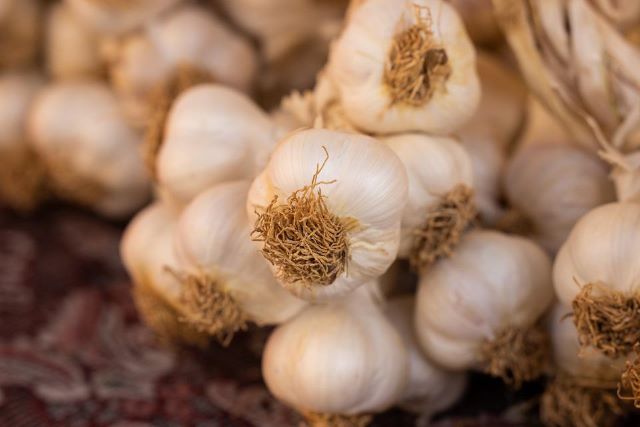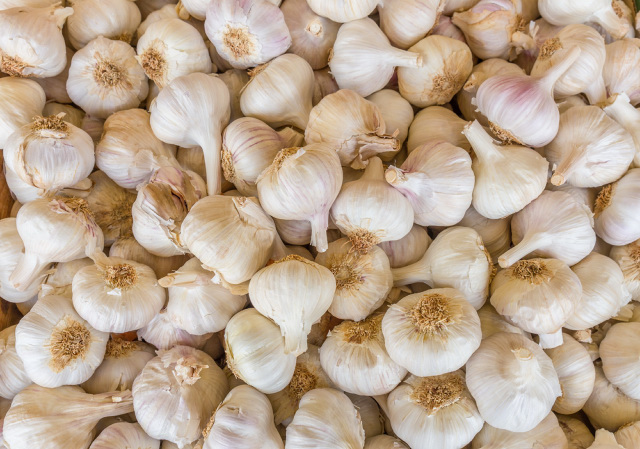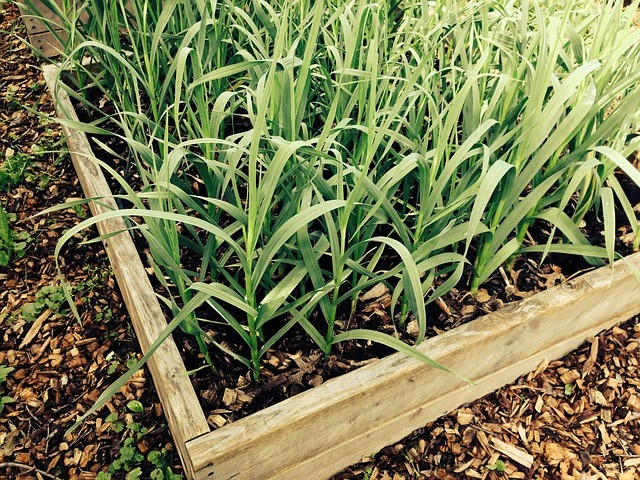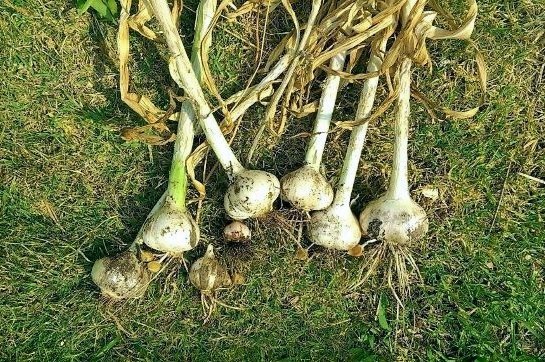You’ll often hear people say you can never have too much garlic, but what about when you have too little? If your garlic bulbs are looking very small, there could be a number of reasons for this.

Small garlic bulbs are commonly a result of planting the wrong variety, sowing at the wrong time, overcrowding, poor soil conditions, incorrect watering, and harvesting garlic at the wrong time.
Let’s look at each possible reason for your garlic being small and how you can fix the problem for a bigger harvest of garlic.
Table of Contents
- Planting the Wrong Cloves Can Cause Small Garlic Bulbs
- Planting at the Incorrect Time Can Lead to Small Garlic Bulbs
- Overcrowding Can Cause Garlic Bulbs to be Small
- Poor Soil Conditions Can Cause Garlic Bulbs to be Small
- Incorrect Watering of Garlic Can Lead to Smaller Bulbs
- Harvesting Garlic at the Wrong Time Can Leave You with Smaller Bulbs
Planting the Wrong Cloves Can Cause Small Garlic Bulbs

If you are planting the wrong variety of garlic, or are accidentally planting smaller cloves from smaller bulbs, you could be setting yourself up for disappointment before your new plants have even taken root. Planting small cloves from small bulbs could lead to equally small bulbs developing later.
Bigger is always better when it comes to garlic. Big bulbs and big cloves are likely to lead to more big bulbs and big cloves. Make sure, when selecting cloves to plant yourself, that you keep the biggest, blemish-free ones to go back into the soil.
Always try to pick organic garlic that has escaped chemical treatment. Otherwise, you could end up disappointed with cloves that refuse to root once they’re planted. When in doubt, always source from reputable organic traders or local producers who know exactly where and how the crop has been previously.
Hardneck varieties do better in colder weather. Softneck varieties are better suited to warmer climates, such as California, the biggest producer of garlic in the States.
Some popular varieties known for reliably producing larger bulbs include artichoke, porcelain, and purple stripe. Keep a lookout for these if you want to plant varieties that are less likely to produce smaller yields.
Planting at the Incorrect Time Can Lead to Small Garlic Bulbs
Garlic needs a period of cold in order to develop properly. This process is referred to as vernalization. Vernalization is the process by which plants monitor seasonal progression through temperature. They will then time their growth based on these cues.
Garlic whose growth isn’t properly timed is less likely to be able to produce big, healthy bulbs.
Hardneck varieties, in particular, should be planted in the fall, a few weeks before the appearance of the first winter frost. Most people advise anywhere between 3 and 6 weeks. Timing can be a bit tricky, but you essentially need to give your newly planted cloves enough time to grow small roots and establish themselves.
Once the cold weather hits, the planted garlic will become dormant, before growing again the following spring once temperatures warm up.
Softneck varieties can be planted in early spring, but make sure it really is early. Even softneck varieties need a period of vernalization, or cooler weather, in order to develop properly.
Garlic that’s planted too early in the fall can grow too much and waste well-needed energy before the actual growing season. Garlic planted too late may not have time enough to develop a decent root foundation. This can deprive it of a healthy start once warmer weather returns.
Similarly, softneck varieties planted too late in the spring may not have enough cold weather to develop and establish themselves properly.
Overcrowding Can Cause Garlic Bulbs to be Small

To ensure your bulbs have the best chance of growing fat, they need space. Garlic doesn’t like competition, not from its cousins and especially not from weeds.
Space your garlic out at least 3 inches from one another. Most gardeners will tell you you need more than this, with some recommending a minimum of 5 or even 6 inches. Although garlic is still likely to grow if you pack it together, the bulb development underground will be inhibited if it’s given too little space.
Garlic doesn’t enjoy the company of weeds. Start weeding competitive, unwanted plants from the ground as soon as spring hits. Putting mulch down at the same time as planting can also help suppress unwanted growth. It can also protect dormant garlic from the extreme cold over the winter months.
Aim to plant your garlic about 3 inches deep, a few inches more if you don’t mulch, as too close to the surface could leave it vulnerable to extreme cold. On the other hand, you don’t want to plant it much deeper than 6 inches if you want to ensure bulbs are given enough space to grow. Too deep down and the soil pressure can start to inhibit bulb growth.
Finally, garlic will usually start growing between the first signs of spring and the hotter end of summer. Try to extend this period as much as possible. This can give your bulbs more time to grow fat. Keeping your garlic protected from extreme bursts of heat is one way to do this. If you live in a very hot or sunny area, consider planting your garlic somewhere where it is not exposed to the sun for the entire day.
Poor Soil Conditions Can Cause Garlic Bulbs to be Small
Garlic does best in slightly sandy, loamy soil. Plenty of organic matter is needed to keep the soil well fed and properly draining. The best way to improve the quality and drainage of thick, clay-like soil is by digging through plenty of fine organic compost prior to planting.
If the soil is particularly tough, bulbs are going to have to work harder to grow outwards. Try breaking up tough or thick soil with a hoe or spade before planting. If it’s particularly clay-like, give it a few days to dry out and soften once you’ve disturbed it.
The mulch you’ve added to help suppress weeds will also help add to the organic health of the soil over time. You can also thin out the mulch in spring and add an organic fertilizer to help during the growing season. Garlic bulbs will do best if they’re properly nourished.
You may come across varied advice when it comes to what balance of nutrients to give your soil when growing garlic. Many soils are deficient in nitrogen, so a nitrogen-focused fertilizer may sometimes be recommended. However, too much nitrogen in the soil can lead your garlic to prioritize green top growth over bulb development.
You can try home-testing your soil to see how it is balanced for nutrients. In the absence of such data, a good, all-purpose organic fertilizer should be sufficient to ensure your soil is giving your garlic bulbs the best possible nourishment.
Incorrect Watering of Garlic Can Lead to Smaller Bulbs
Proper watering is essential to ensure the garlic doesn’t dry out. It’s a tough plant, one that can survive dry spells, but this will be at the expense of large bulb growth. If you’re in a particularly dry climate, keeping good layers of mulch down to retain moisture in the soil is a good move.
Keep soil slightly and evenly moist throughout the growing season. Ensuring the soil is well-draining will also help ensure the garlic doesn’t stagnate in too much water. An excess of water can lead to the plants rotting before they’re fully grown, which can lead to withered or spoiled bulbs.
Hardneck varieties of garlic grow something called scapes, a green shoot that extends directly from the top of the plant. The good news about scapes is that they’re edible! Harvest them by cutting them from the plant as soon as they develop their first curl. This can help to encourage bigger bulb growth.
By harvesting scapes regularly you are allowing the garlic to focus its energy on developing bulbs underground. In the meantime, try frying the scapes, eating them raw as a salad garnish, or blending them to make pesto. They tend to have a sweet and mild garlicky taste – a taste of what’s to come, you might say!
Harvesting Garlic at the Wrong Time Can Leave You with Smaller Bulbs

Just as it can be tricky to judge when to put your garlic into the ground, gardeners can also feel a bit uncertain about when to take it out. You want to choose the right moment when your bulbs are as big as they can be, but not before the plant dies back completely!
A good starting point is to watch until the bottom 3 or 4 leaves of the garlic plant have turned brown. This is an indication that the plant has started to die back. The leaves at the top should still be green and healthy-looking.
You can also judge it by proportion – when anywhere between a third and a half of the bottom leaves have turned brown or yellow, this is usually a good time to harvest.
Waiting for too long once the plant has started to die back can reduce the shelf life of your harvested bulbs, without necessarily resulting in them getting any bigger. It can also make them more vulnerable to rot.
Related Reading:
